
This California species of _____ ____ was almost wiped out, but a single pair were found hidden in the tule marshes of Buena Vista Lake in Kern County.
What are: Tule Elk
That pair were given refuge and allowed to breed by landowner Henry Miller, who ran the gigantic Miller and Lux ranch in the Central Valley. All of the 4,000 or so Tule Elk alive today descend directly from that pair, the Tule Elk's Adam and Eve.
Of the 33 species of snakes in Northern California, only ____ are venomous to humans, and all six are varieties of _________.
What is: six and rattlesnake
The Columbian ______-_____ ____ (O. h. columbianus) is found in western North America, from Northern Californiainto the Pacific Northwest and coastal British Columbia.
What is: The Columbian black-tailed deer.

The ________ ________ (Mustela altaica), primarily lives in high-altitude environments, as well as rocky tundra and grassy woodlands.
What is: The mountain weasel

The _____-______ _______ ,is a large, stout-bodied ground squirrel.
What is: A yellow-bellied marmot
It is one of fourteen species of marmots, and is native to mountainous regions of southwestern Canada and western United States, including the Rocky Mountains, Sierra Nevada, and Mount Rainier in the state of Washington, typically living above 6,500 feet (2,000 m). The fur is mainly brown, with a dark bushy tail, yellow chest and white patch between the eyes, and they weigh up to approximately 5 kg (11 lb). They live in burrows in colonies of up to twenty individuals with a single dominant male. They are diurnal and feed on plant material, insects, and bird eggs. They hibernate for approximately eight months starting in September and lasting through the winter.

This endangered subspecies is found only in salt marshes between Morro Bay and San Francisco Bay.
What is: The California clapper rail
It's endangered for two main reasons. First, its preferred habitat, the stands of native cordgrass and pickleweed has mostly been filled in or otherwise destroyed.
Second, during the Gold Rush era, California clapper rails were considered mighty good eating.

The most common snake in northern California -- and one often mistaken for a rattlesnake -- is the Pacific ______ ______.
What is: The Pacific gopher snake
Gopher snakes range in color from gray to dark brown and sport alternating black and brown spots along the length of their bodies. This snake is diurnal, meaning it hunts during the day and sleeps at night. When threatened, the snake will flatten its body and shake its tail. While it has no rattle, a rattling sound can be heard in dry grasses, leading observers to believe it to be a rattlesnake. The gopher snake is nonvenomous and not harmful to humans.
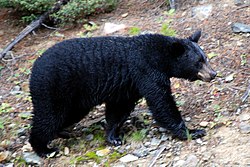
There are between 25000 and 35000 ______ ______ in the state.
What is: Black Bears
It is the continent's smallest and most widely distributed bear species. American black bears are omnivores, with their diets varying greatly depending on season and location. They typically live in largely forested areas, but do leave forests in search of food. Sometimes they become attracted to human communities because of the immediate availability of food.

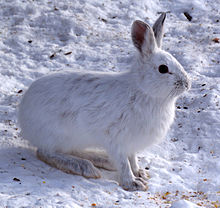
The ________ ____ (Lepus americanus), is found in North America.
What is: The snowshoe hare (Lepus americanus), also called the varying hare, or snowshoe rabbit, is a species of hare found in North America. It has the name "snowshoe" because of the large size of its hind feet.

The _______ ________ is a pine squirrel found in the Pacific coastal states of the United States.
What is: The Douglas squirrel
It is sometimes known as the chickaree or pine squirrel. The Native Americans of Kings Rivercalled it the "Pillillooeet", in imitation of its characteristic alarm call.

The remaining members of the subspecies are restricted to San Mateo County and the very northern edge of Santa Cruz County.
What is: The San Francisco garter snake (Reptiles)
The San Francisco garter no longer lives in the City and County for which it was named: development of its preferred freshwater wetland habitat drove it out of the city.
 A common northern California snake is the _________. Most have some red coloring on their bodies. This snake as a species is very fast and will flee rather than fight when discovered.
A common northern California snake is the _________. Most have some red coloring on their bodies. This snake as a species is very fast and will flee rather than fight when discovered.
What are: The coachwhip

This _____ _____ is the only American canid that can climb trees.
What is: The grey fox
Though it was once the most common fox in the eastern United States, and still is found there, human advancement and deforestationallowed the red fox to become more dominant. The Pacific States still have the gray fox as a dominant.

What is: the Chipmunk
Small, striped rodents of the family Sciuridae. Chipmunks are found in North America.

It is found near large bodies of open water with an abundant food supply and old-growth trees for nesting.
What is: The bald eagle
The bald eagle is an opportunistic feeder which subsists mainly on fish, which it swoops down and snatches from the water with its talons. It builds the largest nest of any North American bird and the largest tree nests ever recorded for any animal species, up to 13 ft deep, 8.2 ft wide, and 1 metric ton in weight.

This distinctive coastal salamander with the orange and brown two-tone paint job, secretes the same deadly toxin that makes eating pufferfish a risky venture.
What is: The California newt
Tetrodotoxin, a neurotoxin about a hundred times as dangerous per gram as potassium cyanide, can cause swift and unpleasant death by respiratory failure. Though at least one human fatality has been reported involving someone who swallowed newts on a dare.
 The sharply pointed barb at the end of the _____-_____ snake's tail looks deadly, it's actually merely a protruding remnant of the snake's tail vertebra and is not toxic and cannot hurt humans.
The sharply pointed barb at the end of the _____-_____ snake's tail looks deadly, it's actually merely a protruding remnant of the snake's tail vertebra and is not toxic and cannot hurt humans.
What is the Sharp-tailed Snake
Instead, the spiny point is used to hold slugs and small prey for the sharp-tailed snake to eat. The top of the sharp-tailed snake ranges in colors to suit its surroundings -- from forest brown to desert clay red -- and the underbelly is striped in black and white. This snake is very shy and may play dead when discovered hiding under a rock or rotting wood.

Secretive and largely solitary by nature, the _______ is properly considered both nocturnal and crepuscular, although daytime sightings do occur.
What is: The Cougar
An adaptable, generalist species, the cougar is found in most American habitat types. It is the biggest cat in North America,[6] and the second-heaviest cat in the New World after the jaguar.

The _______ _______
What is: The hermit thrush

The ______ ______ is a large, long fish with a tapering head. It can grow up to 24 inches in larger lakes. Its rather large suckermouth is located on the bottom of the head.
What is: The Tahoe sucker

California's state fish since the 1940s, the taxonomically confusing _____ ______ is native to a few high-elevation tributaries of the Kern River east of Lake Isabella.
What is: The Golden Trout
We say "taxonomically confusing" because, as is the case with a whole lot of other trout and salmon in the genus Oncorhynchus, the experts aren't in complete agreement as to the precise identity of the golden trout.

A popular pet for reptile owners, the ________ ________ can also be found endemically throughout northern California.
What is the California Kingsnake?
Although they are nonvenomous, the kingsnake is so called for its ability to dominate other snakes as food, including venomous rattlesnakes. When disturbed, the California kingsnake will mimic the rattlesnake's curl and tail rattle as a form of defense.
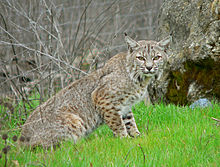
The ________ is an adaptable predator that inhabits wooded areas, as well as semidesert, urban edge, forest edge, and swampland environments.
What is: The bobcat
With a gray to brown coat, whiskered face, and black-tufted ears, the bobcat resembles the other species of the midsized genus Lynx.
It has distinctive black bars on its forelegs and a black-tipped, stubby (or "bobbed") tail, from which it derives its name.
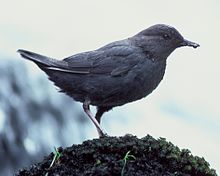
_______ are named for their bobbing or _______ movements. They are unique among passerines for their ability to dive and swim underwater.
What is: Dippers

A medium-sized American songbird.
What is: The western tanager. It has recently been classified in the cardinal family.
They build a flimsy cup nest on a horizontal tree branch, usually in a conifer. They lay four bluish-green eggs with brown spots.
These birds migrate, wintering from central Mexico to Costa Rica. Some also winter in southern California.

Republican legislators hate this insect. A citizen of one of California's fastest-disappearing habitats, the Central Valley's stream-side woodlands.
What is: The Valley Edlerberry Longhom Beetle (Desmocerus Californicus Dimorphus)

Of all the rattlesnake types, only the ________ _________ is found in northern California. Pacific rattlesnakes can reach a length of 5.5 feet, and the skin color ranges from dark gray to nearly black, with hexogonal markings.
What is the Pacific rattlesnake?
When surprised, the rattlesnake will coil, rear its head back and rattle fiercely; be wary as it may strike at any time. Fortunately, the Pacific rattlesnake is usually active only in the spring and summer months and will hibernate from November to February. In the springtime, mornings and late afternoons are the times to be aware of potential rattlers, as this is when they hunt. When the weather turns hotter, the snake becomes nocturnal and is rarely seen during the day.
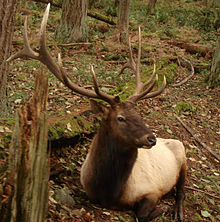
It is the largest of the four surviving subspecies of ____ in North America.[1] Their range includes the rain forests of the Pacific Northwest, extends to parts of northern California.
What is: The Roosevelt elk
The desire to protect the elk was one of the primary forces behind the establishment of the Mount Olympus National Monument (later Olympic National Park) in 1909.

What is: The Sierra rosy finch

________ are known for building dams, canals, and lodges (homes). They are the second-largest rodent in the world (after the capybara). Their colonies create one or more dams to provide still, deep water to protect against predators, and to float food and building material.
What is: The beaver
The North American beaver population was once more than 60 million, but as of 1988 was 6–12 million. This population decline is the result of extensive hunting for fur, for glands used as medicine and perfume, and because the beavers' harvesting of trees and flooding of waterways may interfere with other land uses.[2]
